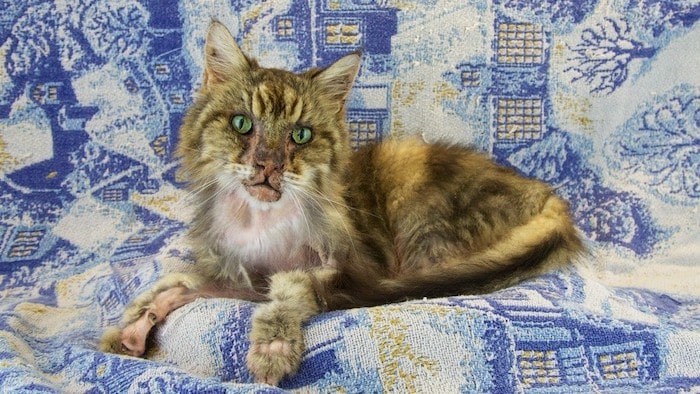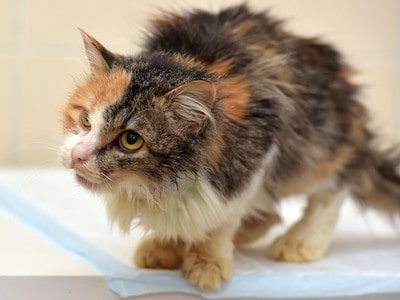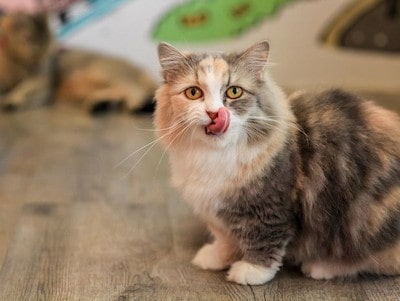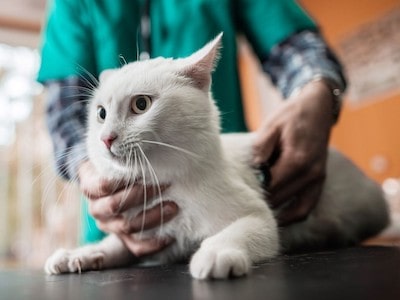Just like humans, our feline companions can also experience hormonal imbalances that affect their overall health and well-being. As responsible pet owners, it’s crucial to stay informed about the various health issues that can arise in our feline friends.
Hyperthyroidism, characterized by an overactive thyroid gland, is one such condition that requires our attention.
In this article, we will explore the causes, symptoms, and treatment options available for hyperthyroidism in cats, ensuring that you have the knowledge and understanding to provide the best possible care for your four-legged companion.
So, let’s dive into the depths of hyperthyroidism in cats and uncover the essential information you need to know to keep your feline friend healthy and thriving.
What is Hyperthyroidism?
The condition known as hyperthyroidism is brought on by an overproduction of thyroid hormone by the thyroid gland. The thyroid gland is a small organ in the neck that produces hormones that control a variety of bodily functions, including heart rate, metabolism, nervous system activity, and more.
Too much thyroid hormone production makes the body work harder and quicker than usual, which can result in a number of issues.

The most prevalent hormonal condition affecting cats is hyperthyroidism, which primarily affects cats in their middle and later years. Although cats as young as 4 or as old as 20 might be diagnosed, the typical age of diagnosis is approximately 13. In young cats, hyperthyroidism is uncommon.
The most common cause of hyperthyroidism is an adenoma, a benign (non-cancerous) tumour that develops on the thyroid gland and causes it to generate extra hormone.
Adenocarcinomas are a kind of malignant (cancerous) tumour that, in a few uncommon circumstances, can lead to hyperthyroidism. Although the exact causes of these tumours is unknown, there are a number of potential causes, including nutrition, environment, and genetics.
What are the Symptoms of Hyperthyroidism?
Hyperthyroidism can cause a variety of symptoms that may be subtle at first but become more severe as the disease progresses. The most common symptoms of hyperthyroidism are:
- Weight loss: Cats with hyperthyroidism tend to lose weight despite eating more than normal and having an insatiable hunger because of their very fast metabolism, which burns more calories than they take in.
- Increased appetite: Cats with hyperthyroidism may exhibit constant hunger, beg for food, or steal from people or other animals. They could also consume more quickly and voraciously than usual.
- Increased thirst and urination: In addition to drinking more water than normal, cats who have hyperthyroidism may also pee more frequently and heavily. The reason for this is that their kidneys must use more effort to remove the extra thyroid hormone from their blood.
- Vomiting and diarrhea: Due to their increased hunger and digestive issues, cats with hyperthyroidism may vomit or have diarrhea. Additionally, they could vomit or urinate with blood or mucus in them.

- Rapid breathing: As a result of their raised heart rate and blood pressure as well as the requirement for extra oxygen to sustain their heightened metabolism, cats with hyperthyroidism may breathe more rapidly and forcefully than usual.
- Difficulty breathing: Cats with hyperthyroidism may have trouble breathing due to their enlarged thyroid gland pressing on their windpipe or due to heart or lung problems caused by the disease.
- Heart problems: Hypertrophic cardiomyopathy, a kind of cardiac disease marked by the thickening of the heart muscle that makes it more difficult for the heart to adequately pump blood, can occur in hyperthyroid cats. This may result in abrupt death, blood clots, irregular cardiac rhythms, or heart failure.
- Hyperactivity and restlessness: Cats with hyperthyroidism may be more active and restless than normal because they have too much energy and cannot relax. They may also be more irritable and aggressive due to their increased nervous system activity.
- Unkempt appearance: Cats with hyperthyroidism may have a poor body condition and a dull, matted, or greasy coat due to their weight loss, vomiting, diarrhea, and lack of grooming. They may also have thickened nails due to their increased blood flow.
What are the Causes of Hyperthyroidism?
Hyperthyroidism is caused by hyperfunctioning thyroid nodules that produce excess thyroid hormone outside of the control of the pituitary gland, which is the master gland that regulates the thyroid gland.
But what causes these nodules to form and grow? There are several theories about what may trigger or contribute to hyperthyroidism in cats, but none of them have been proven conclusively. Some of the possible factors include:
Diet
Some reports have linked hyperthyroidism in cats to some fish-flavored canned food diets that may contain high levels of iodine, which is an essential element for thyroid hormone production.
Some studies have also suggested that some canned foods may contain thyroid-disrupting chemicals, such as bisphenol A (BPA) or polybrominated diphenyl ethers (PBDEs), that may interfere with the normal function of the thyroid gland.

Environment
Some studies have suggested that exposure to thyroid-disrupting chemicals in food or the environment may contribute to hyperthyroidism in cats.
These chemicals may include pesticides, herbicides, flame retardants, plastics, and other household or industrial products that may mimic or block the action of thyroid hormones or affect their metabolism.
Genetics
There is no known genetic predisposition for hyperthyroidism, but it may be more common in certain breeds or populations of cats. For example, some studies have found that hyperthyroidism is more prevalent in Siamese, Himalayan, Burmese, and Abyssinian cats than in other breeds.
Some studies have also found that hyperthyroidism is more common in cats from certain geographic regions, such as the Pacific Northwest or the Northeast of the United States.
How is Hyperthyroidism Treated?
If your cat is diagnosed with hyperthyroidism, you should consult with your veterinarian about the best treatment option for your cat. There are four main treatment options for feline hyperthyroidism: medication, radioactive iodine therapy, surgery, and dietary therapy.
Each option has its advantages and disadvantages, and the choice depends on your cat’s individual situation and your preference. Here is a brief overview of each option:

Medication
Medication involves giving oral or transdermal drugs that inhibit the production of thyroid hormones by the thyroid gland.
The most common drug used for hyperthyroidism is methimazole, which can be given as a tablet, a liquid, or a gel that is applied to the skin. Another drug that can be used is carbimazole, which is converted to methimazole in the body.
Medication does not cure hyperthyroidism but controls it by reducing the symptoms and normalizing the hormone levels.
Medication requires lifelong administration and regular monitoring of blood levels and side effects. Some cats may not tolerate medication well or may develop resistance to it over time.
Some of the possible side effects of medication include:
- Vomiting
- Diarrhea
- Loss of appetite
- Itching
- Skin lesions
- Liver problems
- Blood disorders
- Facial swelling
Radioactive Iodine Therapy
Radioactive iodine therapy involves injecting a radioactive form of iodine (I-131) into the cat’s bloodstream, which is quickly absorbed into the thyroid gland and selectively destroys the abnormal thyroid tissue without affecting the normal tissue or other organs. This treatment can cure hyperthyroidism in most cases without causing side effects or complications.
Radioactive iodine therapy is considered the most effective and safest treatment option for hyperthyroidism, but it requires hospitalization and isolation of the cat for a few days or weeks until the radiation level is safe for humans and other animals to be around. This treatment may not be available in all areas or affordable for all owners.
Surgery
Surgery involves removing the affected thyroid gland or glands under general anesthesia. Surgery can cure hyperthyroidism if all the abnormal thyroid tissue is removed, but it carries some risks and complications, such as:
- Bleeding
- Infection
- Damage to the parathyroid glands or the laryngeal nerves
- Low blood calcium levels
- Recurrence of hyperthyroidism if some thyroid tissue is left behind or if there is ectopic thyroid tissue
Surgery requires preoperative stabilization of the cat’s condition and postoperative monitoring of blood calcium levels and hormone levels. Surgery may not be suitable for cats with other health problems or older cats.
Dietary Therapy
Dietary therapy involves feeding the cat a low-iodine diet that limits the amount of thyroid hormone that can be produced by the thyroid gland. Dietary therapy can control hyperthyroidism without causing side effects, but it requires strict adherence to the diet and no other food or treats.
Dietary therapy may take several weeks to show results and may not be effective for all cats. Dietary therapy may not be suitable for cats with kidney disease or other dietary requirements.
FAQs
How is hyperthyroidism in cats diagnosed?
To diagnose hyperthyroidism in cats, your veterinarian will perform a thorough physical examination, review the cat’s medical history, and may conduct blood tests to measure the levels of thyroid hormones. Additional diagnostic procedures such as thyroid imaging (ultrasound or scintigraphy) or a thyroid biopsy may be recommended in certain cases.
Can hyperthyroidism in cats be cured?
Hyperthyroidism in cats can be effectively managed and controlled, but it may not be completely cured. Treatment aims to normalize thyroid hormone levels and alleviate the symptoms. With appropriate treatment and ongoing monitoring, cats with hyperthyroidism can live long and healthy lives.
Can hyperthyroidism in cats lead to other health complications?
If left untreated, hyperthyroidism in cats can lead to various complications, including heart problems, high blood pressure, kidney disease, and weight loss. It’s essential to diagnose and manage hyperthyroidism promptly to minimize the risk of associated health issues.
Is hyperthyroidism in cats a common condition?
Yes, hyperthyroidism is one of the most common endocrine disorders seen in older cats. It primarily affects cats over the age of 10, although it can occur in younger cats as well. Regular veterinary check-ups and early detection are crucial in managing this condition effectively.
Well, It’s a Wrap
In conclusion, hyperthyroidism in cats is a significant health concern that requires attention and proper management. By familiarizing ourselves with the causes, symptoms, and treatment options, we can provide the best care for our feline companions.
Regular veterinary check-ups, early detection, and appropriate treatment are key in ensuring the well-being of cats with hyperthyroidism.
Remember, the symptoms of hyperthyroidism can vary from cat to cat, so it’s important to be vigilant and seek veterinary care if any unusual changes occur.
With the guidance of a veterinarian, you can explore different treatment approaches, such as medication, radioactive iodine therapy, or surgery, to find the most suitable option for your cat’s specific needs.
